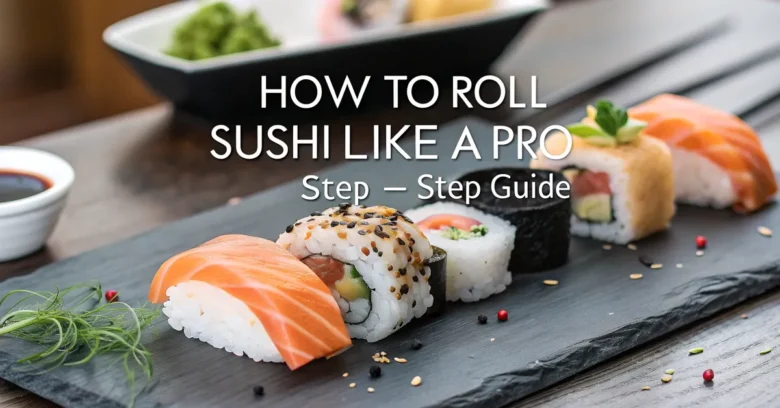Want to wow your friends and family with beautiful sushi rolls? It may seem like a craft reserved for seasoned chefs, but with a little practice and the right guidance, you can absolutely master the art of rolling sushi at home.
Many people think that rolling sushi is hard. Some even think that it is a skill that is only reserved for those with many years of experience. But you can avoid all this.
This step-by-step guide will take you from sushi novice to sushi-rolling pro in no time! We will cover all the basics, from preparing the rice and choosing the right ingredients to mastering the rolling technique.
What You’ll Need to Roll Sushi
Before we dive into the process, let’s gather our tools and ingredients. Having everything ready will make the sushi-making experience smoother and more enjoyable. Here’s a list of essentials:
- Sushi Rice: The heart of any sushi roll. Short-grain Japanese rice is best due to its high starch content, which gives it the necessary stickiness.
- Rice Vinegar: Used to season the cooked rice, adding a tangy flavor that complements the other ingredients.
- Nori Seaweed Sheets: Thin, dried seaweed sheets used as the wrapper for the sushi roll.
- Bamboo Rolling Mat (Makisu): A tightly woven mat that helps you shape the sushi roll.
- Fillings: The possibilities are endless! Popular choices include fresh fish (sushi-grade), vegetables (cucumber, avocado, carrots), and other ingredients like cream cheese or cooked shrimp.
- Sharp Knife: A very sharp knife is essential for making clean cuts through the sushi roll.
- Cutting Board: A stable surface for preparing your ingredients and cutting the finished rolls.
- Small Bowl of Water: Used to keep your fingers and knife blade moist, preventing the rice from sticking.
- Optional Condiments: Soy sauce, wasabi, and ginger for serving.
Preparing the Perfect Sushi Rice
Good sushi starts with good rice. Here is how you prepare sushi rice:
- Rinse the Rice: Place the rice in a large bowl and cover with cold water. Gently swirl the rice with your hand until the water becomes cloudy. Drain the water and repeat this process several times until the water runs clear. This step removes excess starch, which prevents the rice from becoming too gummy.
- Cook the Rice: You can cook the rice in a rice cooker or on the stovetop. For a rice cooker, follow the manufacturer’s instructions. For stovetop cooking, use a 1:1 rice-to-water ratio (e.g., 1 cup of rice to 1 cup of water). Bring the water to a boil, then reduce the heat to low, cover the pot, and simmer for 15-20 minutes, or until all the water is absorbed. Let the rice steam, covered, for an additional 10 minutes.
- Season the Rice: While the rice is cooking, prepare the rice vinegar mixture. In a small saucepan, combine rice vinegar, sugar, and salt. Heat over low heat, stirring until the sugar and salt dissolve. Do not boil.
- Combine Rice and Vinegar: Transfer the cooked rice to a large, non-metallic bowl. Pour the rice vinegar mixture over the rice and gently fold it in using a rice paddle or spatula. Be careful not to crush the rice grains. The goal is to evenly distribute the vinegar mixture while cooling the rice.
- Cool the Rice: Fan the rice with a hand fan or piece of cardboard while gently folding it. This helps the rice cool down quickly and evenly. The rice should be at room temperature before you start rolling sushi.
Choosing Your Sushi Fillings
The fillings you pick for your sushi rolls will have a very big impact on the flavor and texture of the final product. Fresh, high-quality ingredients are key. Here are some popular choices:
- Sushi-Grade Fish: Salmon, tuna, yellowtail, and snapper are common choices. Ensure the fish is labeled “sushi-grade,” meaning it has been handled and processed to reduce the risk of parasites.
- Vegetables: Cucumber (seeds removed), avocado, carrots (julienned), bell peppers, and asparagus.
- Cooked Seafood: Shrimp, crab sticks (imitation crab), and cooked eel (unagi).
- Other Options: Cream cheese, pickled radish (daikon), and Japanese mayonnaise.
Setting Up Your Sushi-Rolling Station
A well-organized workspace can make all the difference. Here’s how to set up your sushi-rolling station:
- Prepare the Bamboo Mat: Cover the bamboo rolling mat with plastic wrap. This prevents the rice from sticking to the mat and makes cleanup easier.
- Gather Your Ingredients: Arrange your fillings, nori sheets, seasoned rice, and small bowl of water within easy reach.
- Prepare Your Knife: Keep a damp cloth nearby to wipe your knife blade frequently. This will prevent the rice from sticking to the knife as you cut the sushi rolls.
How to Roll Sushi: Step-by-Step
Now for the main event! Follow these steps to roll sushi like a pro:
- Place the Nori Sheet: Place a nori sheet on top of the prepared bamboo mat, shiny side down.
- Spread the Rice: Moisten your hands with water to prevent the rice from sticking. Take a handful of seasoned sushi rice and gently spread it evenly over the nori sheet, leaving a small (about ½ inch) strip of nori uncovered at the top edge farthest from you. The rice layer should be thin and even.
- Add the Fillings: Arrange your chosen fillings horizontally across the center of the rice layer. Don’t overfill the roll, as this will make it difficult to close.
- Roll the Sushi: Lift the edge of the bamboo mat closest to you and fold it over the fillings, tucking the edge of the nori under the fillings. Gently press down on the mat to hold the roll in place.
- Continue Rolling: Continue rolling the mat forward, applying gentle pressure to shape the roll. Keep the fillings tucked inside and the roll tight.
- Seal the Roll: When you reach the uncovered strip of nori at the top, moisten it with a little water. This will help seal the roll. Continue rolling the mat forward until the entire roll is sealed.
- Shape the Roll: Place the rolled sushi on the cutting board with the seam side down. Use the bamboo mat to gently shape the roll into a more uniform cylinder or square.
- Cut the Sushi: Use a very sharp, moistened knife to cut the sushi roll into even pieces. Start by cutting the roll in half, then cut each half into thirds or fourths, depending on the desired size of the sushi pieces. Wipe the knife blade after each cut to prevent sticking.
Types of Sushi Rolls You Can Make
Now that you know how to roll sushi, let’s look at a few popular types:
- Maki: This is the most common type of sushi roll, with the rice and fillings wrapped in nori seaweed.
- Uramaki (Inside-Out Roll): In this type of roll, the rice is on the outside, and the nori is on the inside, surrounding the fillings. The California roll is a popular example of uramaki.
- Temaki (Hand Roll): This is a cone-shaped hand roll with nori on the outside and rice and fillings inside. It’s a more casual and less formal type of sushi.
Inside-Out Rolls (Uramaki): A Detailed Look
Making inside-out rolls (uramaki) is a popular variation. Here’s how it’s done:
- Prepare the Nori and Rice: Follow the same steps as for maki, spreading a thin layer of seasoned rice evenly over the nori sheet, leaving a small strip of nori uncovered at the top.
- Flip the Nori: Carefully flip the nori sheet over so that the rice is facing down on the bamboo mat.
- Add the Fillings: Arrange your chosen fillings horizontally across the center of the nori sheet.
- Roll the Sushi: Lift the edge of the bamboo mat closest to you and fold it over the fillings, tucking the edge of the nori under the fillings. Gently press down on the mat to hold the roll in place.
- Continue Rolling: Continue rolling the mat forward, applying gentle pressure to shape the roll. Keep the fillings tucked inside and the roll tight.
- Seal the Roll: When you reach the uncovered strip of nori at the top, moisten it with a little water. This will help seal the roll. Continue rolling the mat forward until the entire roll is sealed.
- Add Toppings (Optional): Sprinkle sesame seeds, tobiko (flying fish roe), or other toppings over the rice layer for added flavor and texture.
- Cut and Serve: Cut the roll into even pieces using a very sharp, moistened knife.
Hand Rolls (Temaki): A Fun, Casual Option
Hand rolls (temaki) are a great way to enjoy sushi without the need for a bamboo mat. Here’s how to make them:
- Prepare the Nori: Cut a nori sheet in half.
- Add Rice and Fillings: Hold one half of the nori sheet in your hand. Place a small amount of seasoned sushi rice in one corner of the nori. Add your chosen fillings on top of the rice.
- Roll into a Cone: Fold the nori sheet over the rice and fillings, rolling it into a cone shape. Moisten the inside edge of the nori to seal the cone.
- Serve Immediately: Serve the temaki immediately, as the nori can become soggy if left for too long.
Tips for Making Beautiful Sushi Rolls
Here are a few extra tips to help you make sushi that looks as good as it tastes:
- Use High-Quality Ingredients: The better the ingredients, the better the sushi. Choose fresh, sushi-grade fish and crisp, flavorful vegetables.
- Don’t Overfill the Rolls: Overfilling the rolls makes them difficult to close and cut neatly.
- Use a Sharp Knife: A sharp knife is essential for making clean cuts.
- Moisten Your Knife: Keep a damp cloth nearby to wipe your knife blade frequently. This prevents the rice from sticking to the knife as you cut the sushi rolls.
- Practice Makes Perfect: Don’t be discouraged if your first few rolls aren’t perfect. With a little practice, you’ll soon be rolling sushi like a pro.
Common Sushi-Rolling Mistakes to Avoid
Even seasoned sushi chefs can make mistakes. Here are some common pitfalls and how to avoid them:
- Using the Wrong Rice: Short-grain Japanese rice is essential for sushi. Other types of rice will not have the necessary stickiness.
- Not Rinsing the Rice Properly: Rinsing the rice removes excess starch, which prevents it from becoming too gummy.
- Overcooking or Undercooking the Rice: Follow the cooking instructions carefully to ensure the rice is cooked properly.
- Using Too Much Rice: A thin, even layer of rice is all you need. Too much rice will make the roll difficult to close and eat.
- Overfilling the Rolls: Overfilling the rolls makes them difficult to close and cut neatly.
- Not Sealing the Roll Properly: Moisten the uncovered strip of nori with a little water to ensure the roll is sealed tightly.
The Art of Sushi Presentation
Sushi is not just about taste; it’s also about presentation. Here are a few tips for plating your sushi like a pro:
- Arrange the Sushi Neatly: Arrange the sushi pieces neatly on a plate, with the cut sides facing up.
- Garnish with Ginger and Wasabi: Place a small mound of pickled ginger and a dab of wasabi on the plate.
- Add Soy Sauce: Serve the sushi with a small dish of soy sauce for dipping.
- Use Decorative Elements: Consider adding decorative elements like edible flowers, seaweed salad, or a drizzle of sauce to enhance the presentation.
Sushi Safety: What You Need to Know
Eating raw fish comes with some risks. Here are some things you need to know to ensure your sushi is safe to eat:
- Use Sushi-Grade Fish: Always use fish that is labeled “sushi-grade.” This means it has been handled and processed to reduce the risk of parasites.
- Keep Fish Cold: Keep the fish refrigerated at all times.
- Wash Your Hands and Utensils: Wash your hands and utensils thoroughly before preparing sushi.
- Consume Sushi Fresh: Eat the sushi as soon as possible after preparing it. Don’t leave it out at room temperature for more than two hours.
Sushi and Dietary Considerations
Sushi can be a healthy and delicious meal, but it’s important to consider dietary restrictions and preferences. Here are a few things to keep in mind:
- Gluten-Free: Sushi can be gluten-free if you use tamari instead of soy sauce. Tamari is a Japanese soy sauce that is made without wheat.
- Vegetarian and Vegan: There are many vegetarian and vegan sushi options, such as cucumber rolls, avocado rolls, and vegetable tempura rolls.
- Low-Carb: If you’re following a low-carb diet, you can make sushi with cauliflower rice or konjac rice.
- Allergies: Be aware of any allergies your guests may have. Common allergens in sushi include fish, shellfish, and soy.
Beyond the Basics: Advanced Sushi Techniques
Once you’ve mastered the basics, you can try some more advanced sushi techniques:
- Nigiri: Hand-pressed sushi with a slice of fish on top.
- Sashimi: Thinly sliced raw fish served without rice.
- Oshizushi: Pressed sushi made in a wooden mold.
- Chirashizushi: A bowl of sushi rice topped with a variety of ingredients.
Mastering Sushi Rice: Beyond the Basic Recipe
We covered the basics of sushi rice prep, but here are some more tips to take your rice to the next level:
- Experiment with Vinegar Ratios: Some people prefer a tangier rice, while others prefer it sweeter. Adjust the ratio of rice vinegar, sugar, and salt to suit your taste.
- Use High-Quality Rice Vinegar: The quality of the rice vinegar will affect the flavor of the sushi rice. Choose a good-quality rice vinegar for the best results.
- Don’t Overmix the Rice: Gently fold the vinegar mixture into the rice, being careful not to crush the grains. Overmixing can make the rice gummy.
- Cool the Rice Properly: Fanning the rice while folding it helps it cool down quickly and evenly. The rice should be at room temperature before you start rolling sushi.
Getting Creative with Sushi Fillings: Inspiration and Ideas
Don’t be afraid to get creative with your sushi fillings! Here are a few ideas to inspire you:
- Spicy Tuna Roll: Tuna, spicy mayonnaise, and cucumber.
- Dragon Roll: Shrimp tempura, cucumber, avocado, and eel sauce.
- Rainbow Roll: California roll topped with slices of tuna, salmon, yellowtail, and avocado.
- Vegetable Tempura Roll: Assorted vegetable tempura and sweet chili sauce.
- Philadelphia Roll: Smoked salmon, cream cheese, and cucumber.
Sourcing Sustainable Sushi Ingredients
As sushi becomes more popular, it’s important to consider the sustainability of the ingredients. Here are a few tips for sourcing sustainable sushi ingredients:
- Choose Sustainable Fish: Look for fish that is certified by the Marine Stewardship Council (MSC) or the Aquaculture Stewardship Council (ASC). These certifications ensure that the fish is harvested or farmed in a sustainable way.
- Buy Local: Buying local fish and vegetables supports local farmers and reduces the environmental impact of transportation.
- Avoid Overfished Species: Avoid eating overfished species like bluefin tuna and Chilean sea bass.
- Ask Your Fishmonger: Ask your fishmonger about the origin and sustainability of the fish they sell.
The Equipment Upgrade: Beyond the Bamboo Mat
While a bamboo mat is essential for rolling sushi, there are a few other tools that can make the process even easier:
- Sushi Rolling Machine: These machines can help you roll sushi quickly and easily.
- Rice Cooker: A rice cooker ensures that your sushi rice is cooked perfectly every time.
- Sushi Knife: A sushi knife is designed for making clean cuts through sushi rolls.
- Sushi Plate: A sushi plate is a decorative plate designed for serving sushi.
Sushi and Health: Nutritional Benefits
Sushi can be a healthy meal, offering a variety of nutritional benefits:
- Fish: Fish is a good source of protein, omega-3 fatty acids, and vitamins.
- Seaweed: Seaweed is a good source of iodine, minerals, and fiber.
- Rice: Rice provides carbohydrates for energy.
- Vegetables: Vegetables provide vitamins, minerals, and fiber.
However, it’s important to be mindful of the sodium content of soy sauce and the added sugar in some sushi rolls.
Perfect Pairings: Complementing Your Sushi Meal
Complete your sushi experience with complementary dishes and drinks:
- Edamame: Steamed soybeans sprinkled with salt.
- Miso Soup: A savory soup made with fermented soybean paste.
- Seaweed Salad: A refreshing salad made with seaweed, sesame oil, and soy sauce.
- Green Tea: A traditional Japanese tea that pairs well with sushi.
- Sake: A Japanese rice wine that is often served with sushi.
- Japanese Beer: Light and crisp Japanese beers like Sapporo or Asahi are great with sushi.
Troubleshooting Common Sushi Problems
Even with the best preparation, you might encounter some problems. Here’s how to troubleshoot them:
- Rice is Too Sticky: If the rice is too sticky, it may not have been rinsed properly or it may have been overcooked. Try rinsing the rice more thoroughly next time and reducing the cooking time.
- Rice is Too Dry: If the rice is too dry, it may have been undercooked or it may have been left uncovered for too long. Try adding a little more water next time and covering the rice while it cools.
- Rolls are Falling Apart: If the rolls are falling apart, it may be because they are overfilled or the nori sheet is not sealed properly. Try using less filling and moistening the uncovered strip of nori with a little water before sealing the roll.
- Fish is Not Fresh: If the fish smells or looks bad, do not use it. Fresh fish should have a clean, ocean-like smell and a vibrant color.
Sushi Rolling as a Social Activity: Hosting a Sushi Night
Turn sushi-making into a fun social event! Here’s how to host a sushi night:
- Invite Your Friends: Invite a few friends over for a sushi-making party.
- Prepare the Ingredients: Prepare the sushi rice and gather all the necessary ingredients.
- Set Up a Sushi-Rolling Station: Set up a sushi-rolling station with all the tools and ingredients.
- Teach Your Friends How to Roll Sushi: Show your friends how to roll sushi and let them try it themselves.
- Enjoy the Sushi Together: Enjoy the sushi together with your friends.
Can You Really Roll Sushi Like a Pro?
With the right tools, high quality and fresh ingredients, and a little practice, you can definitely roll sushi like a pro! Don’t be afraid to experiment with different fillings and techniques to find what works best for you. Your taste buds, friends and family will thank you for it!



